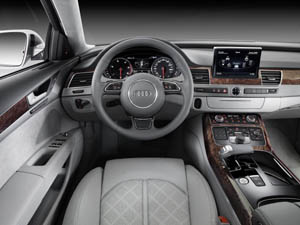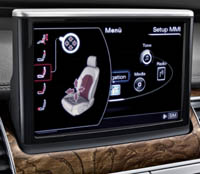|

Audi
Above The Audi A8 interior: one of the nicest places to be.
THE AUDI
A8 OCCUPIES a special position among
German luxury cars. The Mercedes-Benz S-Klasse has a history going
back to the Großer models, and seems to be a default
choice for those who want real luxury in a full-size car. (In 2005,
we tested the S500 with massaging seatsóand concluded it might be
worth spending a quarter-million just to have access to that feature
while in motion.) Its southern rival, the BMW
7er-Reihe, began as a technological tour de force, and went
all baroque, before rediscovering its roots with the latest model.
In that confusion, Audi pounced with its new A8. The
A8 has always been the non-conformist: an aluminium body while the
others used steel, four-wheel drive while the others offered rear-wheel
as standard. It was the adventurous choice for the buyer who didnít
need the respectability of the Mercedes, or the over-the-top baroque
styling of the BMW.
With the latest A8, Audi has taken a step ahead again.
Offering only the 4∑2 TDI in New Zealand
(and, if one does the maths, itís actually 4∑1), it tries to outdo
the competition in every measure. Torque is up to an astounding
800 Nm, which means going from the ton to 180 km/h feels as effortless
as going from 60 to 80 km/h. Maximum torque is available from as
little as 1,750 rpm, hurtling the large car to 100 km/h in 5∑5 seconds.
If the seats werenít as sumptuous and cosseting, that
5∑5 seconds would feel harsher: instead, the acceleration seems
like a gentle push of the occupants into the leather.
It would be a lie to say that you donít feel the bulk
of the A8, but the handling is superb. The car is as manúuvrable
as smaller entries in the Audi rangeóincluding our perennial favourite,
the S3ówith the best handling weíve experienced at this size.
The 350 PS of the A8
TDI doesnít come at too great a penalty
for the environment. While 199 g/km of carbon dioxide wonít please
most environmentalists, itís a fairly respectable figure for the
size of car. Over at Mercedes-Benz, youíd have to go to the S500
4-Matic to beat the Audiís power but not torqueówith a penalty of
67 g/km more carbon dioxide coming out of the tailpipe. To get greater
economy, itís the Bluetec model that will drop the carbon below
200 g/kmóbut youíre only getting 258 PS
from the engine. The claimed fuel economy of 7∑6 l/100 km (37 mpg)
was roughly what we managed to muster on the roads around Cape
Kidnappersóand when you consider that the drag coefficient is
a mere 0,27 with a frontal area of 2∑41 m≤, itís no wonder.
There might not have been a fuel crisis when the A8
was being developed, but Audiís engineers tried to make the car
as frugal as possible. Itís the sort of move we like, because itís
too easy to equip a vehicle with more gear and bigger engines. Creating
efficiency through sensible design is our language.
Not that thereís any sign of skimping anywhere. The
interiorís one of the loveliest weíve been in: Audi has the competition
licked on this front. The sat-nav is well designed, though itís
closely rivalled by what BMW is now
doing. The dashboard design is a pleasing development of earlier
ones: the dials have a thin chrome surround, and are angled toward
the driver; separating rev counter and speedometer is a high-resolution
display with Audiís corporate typeface. Whomever did the graphic
design deserves an award, as it helps propel the interior experience
to the top of the class.
The DVD player in the
A8 is the first weíve found that will play DIVX-encoded
AVI files, which helps extend the
carís entertainment appeal.
But these are still not the A8ís pièces de
résistance. Itís in the adaptive cruise control where
we experienced a taste of that twenty-first century we read about
as children.
While itís not quite the driverless car, this cruise
control is perhaps the most reliable and accurate weíve encountered.
Mercedes-Benz has a reasonably good system, but Audiís will stop
the car for you if need be. Adjusting the following distance is
remarkably simple, and itís even possible to do an entire city journey
without touching the pedals in heavy traffic: itís really that good.
You will, of course, still have to depress the brake pedal yourself
if you are due to be the first to the red light: the system only
stops the car if thereís one in front.
The A8 has a touchpad which you can write letters on
with your finger: that way, you arenít looking at the screen when
dialling in a destination into the sat-nav. Itís better for southpaws
given that weíre a right-hand-drive country and you have to draw
with your left hand.
Safety-wise, the night vision has a thermal imaging
camera which will pick up people, while the Audi Presense system,
in its full option, will even brake the car. Should a collision
happen, Presense has already taken 40 km/h off the speed.
New Zealand models arenít hooked up to Google Maps,
but one party trick on models abroad is Predictive Route, which
adjusts the carís speed to suit the road based on data from the
GPS.
On toys, too, then, the Audi has the competition licked.
And yes, it even has massaging seats, though the three
test cars which we sampled were missing this option. We cannot provide
any back-rubbed comparison with the Merc.
Which only leaves the styling. One thing all the Germans
have had in common over the last decade is upping the garishness
of their cars. The Mercedes has fussy contour lines that take us
back to a 1999 Ford Focus and some 1970s American cars weíd rather
forget; and BMW spent much of the
last decade going for ineleganceówhile experiencing a salesí increase
for tapping into the Zeitgeist. So where is the Audi?
Itís an evolution from the Bauhaus-logical A8 of yesteryear,
but styled to look more imposing and lower to the ground. At some
angles, it seems the crest of the C-pillar drops in one direct line to the boot
lip. The A8 may be aluminium-space-frame-light, but to the eye,
it looks substantial.
That suggests a direct appeal to the plutocrat, an
attempt to steal sales from more baroque rivals. Now that BMW
has gone all lithe and elegant for the new Siebener, the
changes might work in getting Audi extra sales. To us, itís almost
too showy, too flash, meaning that we wouldnít pick it on looks
alone.
It ticks the boxes on so many fronts: itís powerful,
itís fairly economical, and itís arguably the safest car around.
But in a fashion and lifestyle magazine, we need a
dose of irrationality, something to stir the soul, and so often
that comes from styling. The A8 has suddenly become a rational car,
one where you look at the list of features and technology and decide
whether itís for you. The flashing lights and gadgets will impress
many, and we might still pick it over the BMW
and Mercedes, but more with our heads than with our hearts. ē
|
 |
It’s an evolution from the Bauhaus-logical A8
of yesteryear, but styled to look more imposing and lower to the ground. At some angles, it seems the crest of the C-pillar drops in one direct
line to the boot lip. The A8 may be aluminium-space-frame-light,
but to the eye, it looks substantial

Audi
Above Seat adjustment can be done with
the aid of the screen, while the MMI interface is one of the best
we’ve seen.
Jack Yan is publisher of Lucire.
|

